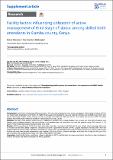Facility Factors Influencing Utilization of Active Management of Third Stage of Labour Among Skilled Birth Attendants in Kiambu County, Kenya
View/
Publication Date
11/26/2016Type
Article, Journalviews
downloads
Metadata
Show full item recordCitation
The Pan African Medical Journal. 2016;25 (Supp 2):11
Abstract/
Introduction: Post-Partum Hemorrhage (PPH) accounts for 34% of maternal deaths in Kenya. Active management of third stage of labour (AMTSL) is a World Health Organization and Ministry of Health of Kenya approved protocol for reducing maternal mortality and morbidity arising from postpartum hemorrhage. Kiambu County in Kenya records an average of six maternal deaths per month, out of which, two are due to PPH. This paper analyses how facility factors influence utilization of this protocol in Kiambu County. Methods: this was a cross sectional study among 431 skilled birth attendants in 52 health facilities. Two hundred and three birth attendants were selected using multistage sampling. Data was collected using questionnaires and observation checklists and analyzed using STATA version 11. Chi square, Fisher’s exact and Logistic regressions tests were used. Results: AMTSL was utilized by 31.5% of the birth attendants. Controlled cord traction (96.5%) was the most utilized. Uterine message after every 15 minutes was the least utilized component. Utilization was more in government facilities (37.4%) (Logistic regression p=0.006) and in level four health facilities (49.5%) (p<0.001). Utilization was higher (34.7%) among birth attendants who experienced less frequent stock outs (p=0.027) and in facilities with more than two staff authorized to order supplies (34.9%) (p=0.020). Utilization was higher in facilities with a fridge (44.5%) (p=0.001) and in facilities with standards documents in the labour ward (68.0%) (p=0.001). Conclusion: health facility factors significantly influence utilization of AMTSL and therefore the county government should put in place strategies to enhance the factors that influence utilization of AMTSL positively.
Subject/
Post-Partum Hemorrhage; Active Management of Third Stage of Labor; AMTSL; Skilled birth attendants; Health facility factors; Maternal mortality
Further Details
© Muiruri Felarmine et al. The Pan African Medical Journal - ISSN 1937-8688. This is an Open Access article distributed under the terms of the Creative Commons Attribution License (http://creativecommons.org/licenses/by/2.0), which permits unrestricted use, distribution, and reproduction in any medium, provided the original work is properly cited.
Publisher
Pan African Medical JournalISSN
1937-8688Series
Strengthening health systems in communities: the experiences of AMREF Health Africa;Supp. 2: 11Collections
- General - GEN [367]

